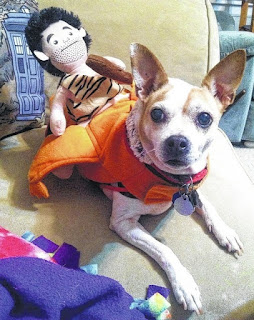It's the time of year of colorful leaves, cool, crisp air and chocolate and candy dispensed from every doorway one night of the season. Halloween is a fun excuse for us to get dressed up in silly costumes. It's also a time for some of our animal family members to wear outfits and regalia that they wouldn't normal be forced to endure. My dog, Marty McFly, has many outfits but only one Halloween costume. Every October 31st a 16 pound mopey-looking pterodactyl shows up for Halloween festivities. Marty rarely finds the humor in the situation, but he tolerates it.
Halloween brings with it some risks that all pet owner's should know
about. Many people know that chocolate is toxic to dogs. Please be conscientious
when it comes to the trick-or-treat treasures which your children bring home.
Chocolate toxicity is based on weight of the pet and amount and type of
chocolate ingested. A small amount of milk chocolate may have no effect on a 50
pound Labrador, but that same amount given to a 5 pound Yorkshire terrier may
have significant consequences. Clinical signs such as vomiting, diarrhea,
increased heart rate, seizures or death may occur. Generally, the darker the
chocolate the more dangerous it is - less of a dose is needed before you'll see
symptoms. For instance, milk chocolate is not as toxic as dark baking chocolate.
If your dog does manage to get chocolate this holiday it's best to
contact your veterinarian right away to discuss whether or not inducing vomiting
is the right thing to do. Oftentimes hydrogen peroxide given orally can bring up
the chocolate (and other stomach contents) in an urgent situation. However, be
aware that inducing vomiting carries with it a risk of getting vomit going back
down the “wrong tube” and can cause aspiration and pneumonia.
Some dogs have learned through their life experiences to bark and carry
on every time the doorbell rings or someone is visiting. This can cause another
Halloween-related hazard when you have multiple mini-goblins, vampires and
superheros ringing your doorbell asking for candy every few minutes. This can
not only be annoying to owners and guests alike it can also be non-stop anxiety
for your pooch. Keeping Fido otherwise occupied in another room, opting out of
candy distribution all together or sitting outside the house to give out candy
so no one rings the bell or knocks may all decrease this anxiety. Some dogs have
such high anxiety about little goblins at your door that they may take the
opportunity to defend you and your property. This is not a good thing if the
little goblins are innocent children enjoying the holiday and are attacked by
scared housepets.
Some pets are known to make a break for it when given an opportunity of a
distracted owner and an open door. Keeping all escape artists confined and away
from the door is an excellent way to decrease the likelihood of a runaway while
you are handing out candy.
This Halloween be aware of the risks associated with the holiday.
Chocolate, ringing doorbells, and open doors are all part of the festivities of
the holiday, however, they can lead to problems with your pets. So keep your
tiny pterodactyls and the mini-goblins safe by being aware of the hazards of the
holiday.
By Dr. Marisa Tong


